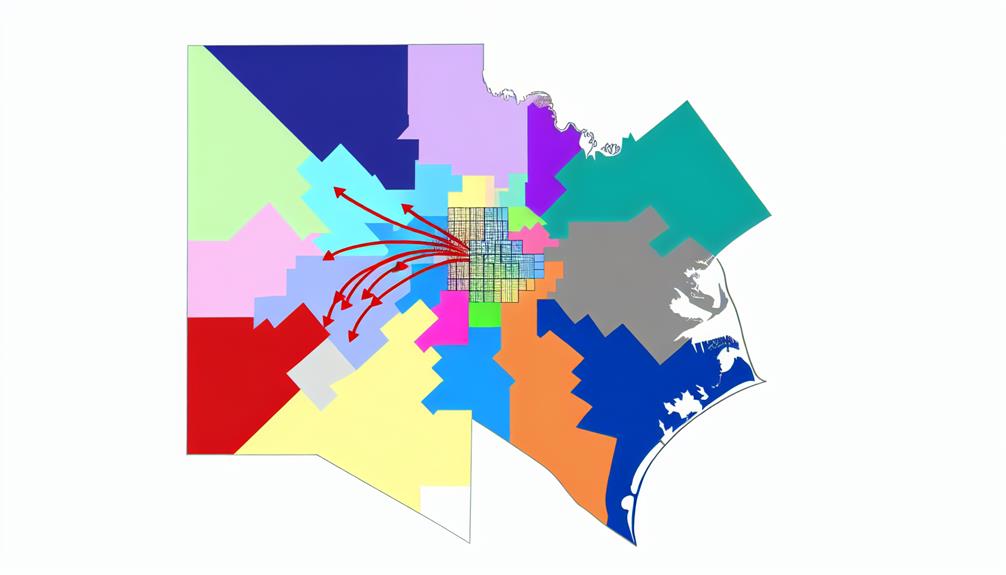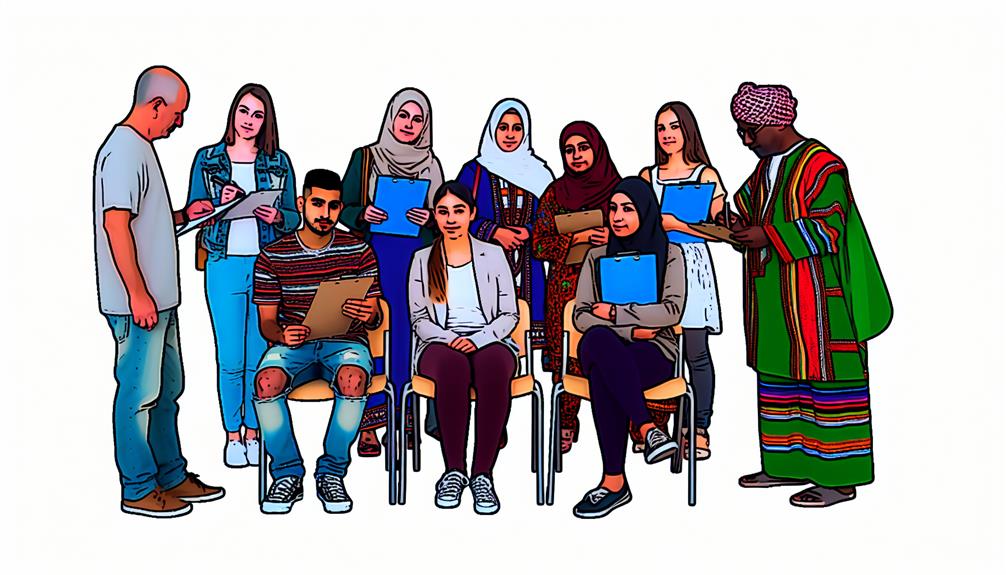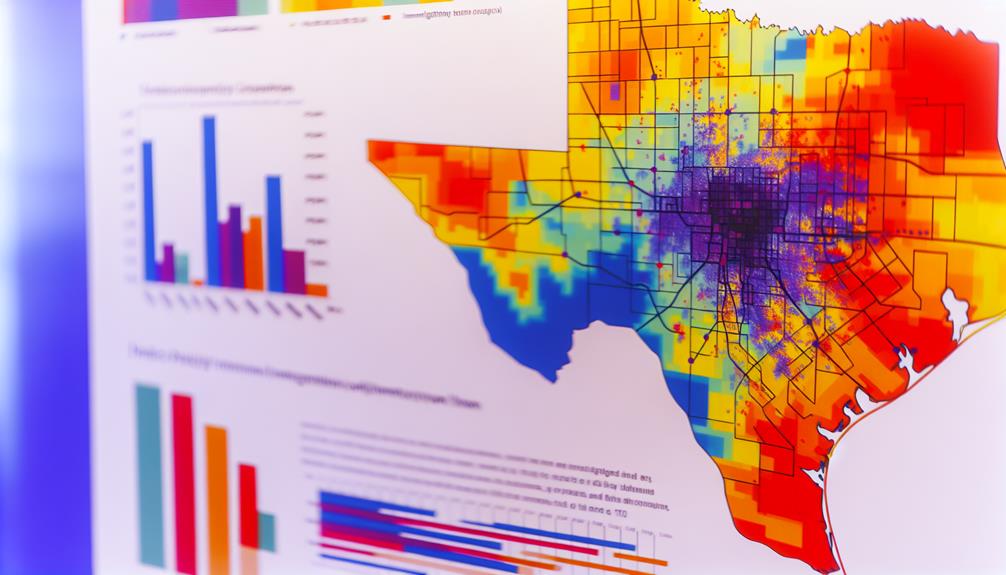Ever thought about what the latest surveys uncover about immigration trends in Houston?
These surveys provide valuable insights into various aspects of the immigrant community in the city, from their economic contributions to the challenges they encounter in blending into society.
Delving into these findings not only illuminates Houston's diverse population but also hints at the future policies and initiatives supporting and empowering immigrant groups.
Get ready for a deep dive into the dynamic landscape of Houston's immigrant scene!
Overview of Houston Immigration Trends

Houston's immigrant population has been on the rise, making a significant impact on the city's overall demographics from 2016 to 2021. During this period, Houston saw a 9.7% increase in its immigrant community, outpacing the 6.3% growth in the total population. Immigrants played a crucial role in shaping Houston's diverse population, contributing to 35.6% of the city's overall population growth.
With one-quarter of Houston residents being immigrants, their presence is undeniably felt in the community. Not only do they enrich the city's cultural fabric, but they also make substantial economic contributions. In 2021, immigrant households in Houston collectively earned an impressive $66.5 billion in income, highlighting their vital role in the local economy. Furthermore, these immigrants paid a total of $16.3 billion in federal, state, and local taxes during the same year, showcasing their significant contributions to the broader community. The data clearly emphasizes the profound impact immigrants have had on Houston's population growth and economic prosperity.
Economic Impact on Immigrant Communities
Houston's immigrant communities are powerhouses when it comes to driving the city's economy. Let's dive into some key stats that shed light on their significant impact:
- Economic Power: In 2021, immigrant households in Houston collectively earned a whopping $66.5 billion, showcasing their vital role in boosting the local economy.
- Tax Support: These communities also contributed a substantial $16.3 billion in federal, state, and local taxes last year. This financial support plays a crucial role in funding public services and infrastructure.
- Spending Influence and Workforce Contribution: Immigrants in Houston wielded a remarkable spending power of $50.2 billion in 2021, fueling consumer activity and driving economic growth. Moreover, immigrant workers made up 31.0% of the city's employed labor force, powering essential industries like STEM, agriculture, and construction. Their presence is pivotal in meeting workforce demands and fostering economic development in various sectors.
Social Integration Challenges Faced by Immigrants

Navigating life as an immigrant in Houston comes with its fair share of challenges, especially when it comes to fitting in with the local community. From language barriers to cultural nuances, the road to integration can be a bumpy one. The lack of accessible resources and support services only adds to the struggle, making it even harder for immigrants to feel like they belong.
Discrimination and prejudice also rear their ugly heads, casting a shadow over social interactions and opportunities for immigrants. Finding affordable housing and healthcare options can feel like an uphill battle, further isolating immigrant communities and making social integration an elusive goal. And let's not forget about the kids – immigrant children often find it tough to adapt to the education system, which can take a toll on their social integration prospects.
To bridge these gaps, we need to start by addressing language barriers head-on. Offering cultural competency training and championing diversity initiatives can go a long way in fostering a more inclusive environment for immigrants in Houston. By recognizing these hurdles and actively working to dismantle them, we can create a community where everyone feels welcome and valued.
Demographic Changes in Houston's Population
Navigating the social scene in Houston as an immigrant brings its own set of challenges, especially with the city's changing demographics. The population trends in Houston, particularly among immigrants, significantly shape the city's fabric. Here are some key stats to give you a snapshot:
- Population Growth: Between 2016 and 2021, Houston saw a 9.7% increase in its immigrant population, outpacing the overall population growth rate of 6.3%. This surge underscores the city's growing diversity.
- Immigrant Population Impact: Immigrants contributed to 35.6% of the total population growth in the Houston metro area during this period, highlighting their substantial influence on the city's demographic shifts.
- Houston Metro Area Makeup: A significant 25% of the Houston metro area's residents are immigrants, showcasing their substantial presence and influence on the city's demographic landscape.
These demographic shifts not only mirror the rise of the immigrant community but also underscore their pivotal role in shaping Houston's evolving identity. It's a testament to the city's vibrant and ever-changing cultural tapestry.
Educational Attainment Among Immigrant Groups

In Houston, immigrants bring a diverse range of educational backgrounds, often exceeding those of native-born residents. The varying levels of education within immigrant communities not only influence their economic impact but also shape their integration into the local workforce.
Education Levels Comparison
In Houston, we see a mix of educational levels among different immigrant groups, especially when it comes to college education. Here's what stands out:
- Some immigrant communities really value higher education, showing higher rates of college graduates among them.
- On the flip side, there are immigrant populations with fewer college graduates, pointing to potential disparities in educational opportunities.
- These differences in educational achievement can affect how well immigrants can meet Houston's workforce needs. It might call for specific efforts to ensure all immigrants have equal chances in the community.
This blend of educational backgrounds among immigrant groups in Houston shapes their contributions to the city and underscores the importance of addressing any gaps in access to education for a more inclusive community.
Impact of Education
The education levels of different immigrant groups in Houston have a direct impact on their job opportunities and contributions to the city's workforce. Immigrants who've college degrees are key players in strengthening Houston's skilled workforce.
It's worth noting that immigrants from countries like India, China, and Nigeria often have higher levels of education compared to the general population. However, there are still educational gaps within immigrant communities that affect their chances of landing higher-paying jobs.
Improving access to educational resources can help bridge these disparities and boost the economic prospects of immigrant groups in Houston. By closing the education gap, immigrants can secure better opportunities for well-paying jobs, which in turn will make a significant contribution to Houston's economy and help them better integrate into the workforce.
Access to Resources
Accessing educational resources is crucial for the success and integration of various immigrant communities in Houston. When we look at the educational achievements of immigrant groups in Houston, we see a few key factors at play:
- Diverse Population: Houston is home to a wide range of immigrant groups, each with varying levels of educational success.
- Challenges to Access: Issues like language barriers and economic hardships can make it harder for some immigrant communities to progress educationally.
- Educational Disparities: Certain immigrant groups, such as those from India and China, tend to have higher education levels in Houston, highlighting disparities within the overall immigrant population.
Understanding and addressing these gaps and obstacles is crucial for supporting the educational advancement and integration of immigrant communities in Houston.
Employment Opportunities and Barriers

In Houston, immigrants are the backbone of various industries, making up 31.0% of the workforce. They play vital roles in STEM, agriculture, and construction sectors, meeting crucial demands.
Despite their significant contributions, challenges like underemployment affecting 67,000 immigrants and brain waste among college-educated immigrants are prevalent, highlighting the barriers they encounter in securing suitable jobs.
Their economic impact is substantial, with a household income contribution of $66.5 billion in 2021. However, income disparities and underemployment continue to be persistent issues within immigrant communities in Houston.
Job Market Analysis
Exploring the job scene for immigrants in Houston uncovers their significant presence and impact across vital industries like STEM, agriculture, and construction.
What You Need to Know:
- Immigrant Workforce: A whopping 31.0% of Houston's working population consists of immigrants, highlighting their pivotal role in the city's employment landscape.
- Industry Focus: Immigrants are key players in rapidly growing fields such as STEM, agriculture, and construction, perfectly aligning with the region's job market demands.
- Underemployment Struggle: Around 67,000 immigrants in Houston face underemployment, preventing them from fully utilizing their specialized skills and expertise.
Understanding these dynamics is crucial for tapping into the potential of immigrant workers and driving economic prosperity in Houston.
Employment Challenges
In Houston, immigrants often face tough challenges landing jobs that match their skills and education, holding back their full potential. The data shows that a whopping 67,000 individuals in Houston are stuck in jobs below their educational qualifications. This issue hits certain immigrant groups hard, like African immigrants, who are especially affected due to specific immigration factors. About one out of every five college-educated immigrants in Houston experiences brain waste, making the situation even more dire. Tackling underemployment among immigrants is crucial not just for their own financial well-being but also for maximizing their economic impact and integration in Houston. Take a look at the table below for a snapshot of the underemployment hurdles immigrants in Houston are up against:
| Underemployment Statistics | Data |
|---|---|
| Total Underemployed Individuals | 67,000 |
| Disproportionate Impact on African Immigrants | Yes |
| College-Educated Immigrants Affected by Brain Waste | 1/5 |
| Broader Job Market Challenges | Present |
| Importance for Economic Contributions | High |
Pathways to Naturalization for Immigrants
A good number of Houston residents who've been living in the U.S. for over 20 years show a strong potential for long-term integration and naturalization. However, challenges like limited English skills, low income, and the high costs of the citizenship application can hinder many immigrants in Houston.
To tackle these issues effectively, several initiatives are in motion:
- 'Naturalize Now, Houston!' Program: This program aims to help residents navigate the naturalization process, encouraging their civic participation and integration into society.
- Boosting Naturalization Rates: Efforts are concentrated on increasing the number of immigrants becoming citizens, especially those who've been in the U.S. for a significant period, like the one-fifth of eligible immigrants in Houston who've been here for at least 50 years.
- Enhanced Support Services: Houston is ramping up support services to assist immigrants in overcoming obstacles such as language barriers and financial limitations, ensuring a smoother path to naturalization and citizenship.
Frequently Asked Questions
What Is the Largest Immigrant Group in Houston?
Houston is home to a diverse mix of immigrants, with the largest group hailing from Mexico, making up about 37% of the foreign-born population. Alongside them, you'll find a growing number of immigrants from countries like Venezuela, Nigeria, Iraq, and Cuba settling in Houston. It's interesting to note that almost half of the kids in Houston have at least one parent who immigrated to the city. This rich tapestry of cultures and backgrounds adds a unique flavor to the city's vibrant community.
What Percentage of Houston Is an Immigrant?
Did you know that in Houston, around a quarter of the population are immigrants? That's higher than both the state of Texas and the national average! And get this, almost half of kids under 18 in Houston have at least one parent who's an immigrant. That's a pretty diverse city, right?
What City in Texas Has the Most Immigrants?
Houston, a bustling Texan city known for its vibrant immigrant community, truly reflects the diverse fabric of America. With almost a quarter of its population made up of immigrants, Houston shines as a top choice for people from all corners of the globe looking to call it home.
In What Area of Texas Did Most Immigrants Settle?
Many newcomers to Texas have made their homes in bustling cities like Houston, Dallas, and Austin. Houston, known for its diverse job market and abundant opportunities, stands out as a popular choice. Harris County, where Houston is situated, has become a magnet for immigrants in search of both economic stability and social connections.
